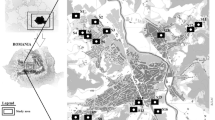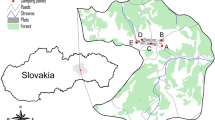Abstract
Based on extensive material, approaches to assessing the risk of accumulation of heavy metals (HM) in vegetable crops grown in open and protected ground, including in hydroponic conditions, are considered. Agrochemical, biochemical, biogeochemical, and sanitary-hygienic aspects of the accumulation of these metals in vegetable products are shown. It is estimated that, in comparison with organic fertilizers, mineral fertilizers play a purely subordinate role as a source of HM for vegetable crops. The situation becomes more complicated when growing these crops in hydroponic conditions, since it is possible to accumulate harmful elements in the commercial part of the product due to the constant contact of plant roots with a nutrient solution containing micro-admixtures of HM. It is shown that the risk of accumulation of HM in vegetable crops can be managed with the help of various strains of microorganisms introduced into the rhizosphere, which contribute both to the immobilization of these metals in the soil or nutrient solution and prevent their entry into the marketable part of vegetable products.




Similar content being viewed by others
REFERENCES
Soldatenko, A.V., Razin, A.F., Shatilov, M.V., Ivanova, M.I., Razin, O.A., Rossinskaya, O.V., and Bashkirov, O.V., Interregional exchange in the context of the alignment of the consumption of vegetables in subjects of the Russian Federation, Ovoshchi Ross., 2018, no. 6, pp. 41–46.
Mamedov, M.I., Prospects of protected ground in Russia, Ovoshchi Ross., 2014, vol. 25, no. 4, pp. 4–9.
Analysis of the fruit and vegetable market. Center for the Economics of Markets. 18.08.2020. https://zen.yandex.ru/media/id/5dd01bd9a28a2f180f2b7c29/analiz-rynka-fruktov-i-ovoscei-5f3aee818936fc6e4ac03127.
Center for Industry Expertise of the Russian Agricultural Bank. Production of greenhouse vegetables in Russia, 26.11.2020. https://tass.ru/ekonomika/10108435.
Pinchuk, E.V., Bespal’ko, L.V., Kozar’, E.G., Balashova, I.T., Sirota, S.M., and Shevchenko, T.E., Valuable vegetable green on hydroponics for seasonal use, Ovoshchi Ross., 2019, no. 3, pp. 45–53.
Lukin, S.V., Miroshnikova, Yu.V., and Avramenko, P.M., Monitoring of the content of heavy metals in the soils of the Belgorod region, Agrokhimiya, 2002, no. 8, pp. 86–91.
Lukin, S.V., Yavtusheno, V.E., and Soldat, I.E., Accumulation of cadmium in agricultural crops depending on the level of soil pollution, Agrokhimiya, 2000, no. 2, pp. 73–77.
Lukin, S.V., Soldat, I.E., and Pendyurin, E.A., Regularities of zinc accumulation in agricultural crops, Agrokhimiya, 1999, no. 2, pp. 79–82.
Lukin, S.V., Yevtushenko, V.E., and Soldat, I.E., Accumulation of cadmium in agricultural crops depending on the level of soil contamination, Eurasian Soil Sci., 2000, vol. 3, no. 1, pp. S91–S95.
Lukin, S.V., Agroekologicheskoe Sostoyanie i produktivnost’ pochv Belgorodskoi oblasti (Agroecological State and Soil Productivity of the Belgorod Region), Belgorod: Konstanta, 2016, vol. 343.
Nagajyoti, P.C., Lee, K.D., and Sreekanth, T.V.M., Heavy metals, occurrence and toxicity for plants: a review, Environ. Chem. Lett., 2010, no. 8, pp. 199–216.
Clemens, S. and Ma, J.F., Toxic heavy metal and metalloid accumulation in crop plants and foods, Annu. Rev. Plant Biol., 2016, vol. 67, pp. 489–512.
Goyer, R.A., Toxic and essential metal interactions, Annu. Rev. Nutr., 1997, vol. 17, pp. 37–50.
Kopittke, P.M., Blamey, F.P.C., Asher, C.J., and Menzies, N.W., Trace metal phytotoxicity in solution culture: a review, J. Exp. Bot., 2010, vol. 61, pp. 945–954.
Hughes, M.F., Arsenic toxicity and potential mechanisms of action, Toxicol. Lett., 2002, vol. 133, no. 1, pp. 1–16.
Li, W.C. and Tse, H.F., Health risk and significance of mercury in the environment, Environ. Sci. Pollut. Res., 2015, vol. 22, pp. 192–201.
Jarup, L. and Akesson, A., Current status of cadmium as an environmental health problem, Toxicol. Appl. Pharmacol., 2009, vol. 238, no. 3, pp. 201–208.
Canfield, R.L., Henderson, C.R., Cory-Slechta, D.A., Cox, C., Jusko, T.A., and Lanphear, B.P., Intellectual impairment in children with blood lead concentrations below 10 μg per deciliter, N. Engl. J. Med., 2003, vol. 348, pp. 1517–1526.
Mergler, D., Anderson, H.A., Chan, L.H.M., Mahaffey, K.R., and Murray, M., Methylmercury exposure and health effects in humans: a worldwide concern, Ambio, 2007, vol. 36, pp. 3–11.
Meharg, A.A., Norton, G., Deacon, C., Williams, P., and Adomako, E.E., Variation in rice cadmium related to human exposure, Environ. Sci. Technol., 2013, vol. 47, pp. 5613–5618.
Akesson, A. Barregard, L., Bergdahl, I.A., Nordberg, G.F., Nordberg, M., and Skerfving, S., Non-renal effects and the risk assessment of environmental cadmium exposure, Environ. Health Perspect., 2014, vol. 122, pp. 431–438.
EFSA (Eur. Food Saf. Auth.). Scientific opinion of the Panel on Contaminants in the Food Chain on a request from the European Commission on cadmium in food, EFSA J., 2009, vol. 980, pp. 1–139.
Clemens, S., Aarts, M.G.M., Thomine, S., and Verbruggen, N., Plant science: the key to preventing slow cadmium poisoning, Trends Plant Sci., 2013, vol. 18, pp. 92–99.
Peralta-Videaa, J.R., Lopez, M.L., Narayana, M., Saupea, G., and Gardea-Torresdey, J., The biochemistry of environmental heavy metal uptake by plants: Implications for the food chain, Int. J. Biochem. Cell Biol., 2009, vol. 41, pp. 1665–1677.
Veltman, K., Huijbregts, M.A.J., and Hendriks, A.J., Cadmium bioaccumulation factors for terrestrial species: Application of mechanistic bioaccumulation model OMEGA to explain field data, Sci. Total Environ., 2008, vol. 406, pp. 413–418.
Scheifler, R., Gomot-de Vaufleury, A., Toussaint, M.-L., and Badot, P.-M., Transfer and effects of cadmium in an experimental food chain involving the snail Helix aspersa and the predatory carabid beetle Chrysocarabus splendens, Chemosphere, 2002, vol. 48, pp. 571–579.
Scheifler, R., de Vaufleury, A., Coeurdassier, M., Crini, N., and Badot, P.-M., Transfer of Cd, Cu, Ni, Pb, and Zn in a soil–plant–invertebrate food chain: A microcosm study, Environ. Toxicol. Chem., 2006, vol. 25, pp. 815–822.
Gimbert, F., Mench, M., Coeurdassier, M., Badot, P.-M., and de Vaufleur, A., Kinetic and dynamic aspects of soil–plant–snail transfer of cadmium in the field, Environ. Pollut., 2008, vol. 152, pp. 736–745.
Jamil, K. and Hussain, S., Biochemical variations in ovaries of water hyacinth weevils Neochetina eichhorniae, Ind. J. Exp. Bot., 1993, vol. 31, pp. 36–40.
Bashkin, V.N., Agrogeokhimiya azota (Agrogeochemistry of Nitrogen), Pushchino: ONTI NTsBI, 1987.
Zhao, F.-J., Ma, Y., Zhu, Y.-G., Tang, Z., and McGrath, S.P., Soil contamination in China: current status and mitigation strategies, Environ. Sci. Technol., 2015, vol. 49, pp. 750–759.
Scientific opinion on lead in food, EFSA J., 2010, vol. 8, p. 1570.
Scientific opinion on the risk for public health related to the presence of mercury and methylmercury in food, EFSA J., 2012, vol. 10, p. 2985.
FAO (Food Agric. Organ. UN), WHO (World Health Organ.). Evaluation of certain food additives and contaminants: seventy-third report of the Joint FAO/WHO Expert Committee on Food Additives. WHO Tech. Report Ser. 960, WHO, Geneva, 2010. http://whqlibdoc.who.int/trs/WHO_TRS_960_eng. pdf.
Chary, N.S., Kamala, C.T., and Raj, D.S.S., Assessing risk of heavy metals from consuming food grown on sewage irrigated soils and food chain transfer, Ecotoxicol. Environ. Saf., 2008, vol. 69, pp. 513–524.
Chien, L.-C., Hung, T.-C., Choanga, K.-Y., Yeha, C.-Y., Mengc, P.-J., and Shiehd, M.-J., Daily intake of TBT, Cu, Zn, Cd and As for fishermen in Taiwan, Sci. Total Environ., 2002, vol. 285, pp. 177–185.
Zheng, N., Wang, Q., and Zheng, D., Health risk of Hg, Pb, Cd, Zn, and Cu to the inhabitants around Huludao Zinc Plant in China via consumption of vegetables, Sci. Total Environ., 2007, vol. 383, pp. 81–89.
Zheng, N., Wang, Q.C., and Zheng, D.M., Transfer characteristics of mercury, lead, cadmium, zinc and cuprum from soil to vegetable around zinc smelting plant, Huan Jing Ke Xue, 2007, vol. 6, pp. 1349–1354.
Yang, Q.W., Lan, C.Y., Wang, H.B., Zhuang, P., and Shu, W.S., Cadmium in soil–rice system and health risk associated with the use of untreated mining wastewater for irrigation in Lechang, China, Agric. Water Manage., 2006, vol. 84, pp. 147–152.
Millis, P., Ramsey, M.H., and John, E.A., Heterogeneity of cadmium concentration in soil as a source of uncertainty in plant uptake and its implications for human health risk assessment, Sci. Total Environ., 2004, vol. 326, pp. 49–53.
Zhiyuan Li, Zh., Ma, Z., der Kuijp, T.J., Yuan, Z., and Huang, L., A review of soil heavy metal pollution from mines in China: Pollution and health risk assessment, Sci. Total Environ., 2014, vols. 468–469, pp. 843–853.
Bashkin, V.N., Modern Biogeochemistry: Environmental Risk Assessment, Springer-Verlag, 2006.
Belogolova, G.A., Sokolova, M.G., and Proidakova, O.A., Influence of soil bacteria on the behavior of chemical elements in the soil–plant system, Agrokhi-miya, 2011, no. 9, pp. 68–76.
Pishchik, V.N., Vorobyev, N.I., Chernyaeva, I.I., Timofeeva, S.V., Kozhemyakov, A.P., Alexeev, Y.V., and Lukin, S.M., Experimental and mathematical simulation of plant growth promoting rhizobacteria and plant interaction under cadmium stress, Plant Soil, 2002, vol. 243, pp. 173–186.
Belimov, A.A., Kunakova, A.M., Safronova, V.I., Stepanok, V.V., and Yudkin, L.Yu., Employment of rhizobacteria for the inoculation of barley plants cultivated in soil contaminated with lead and cadmium, Microbiology, 2004, vol. 73, pp. 99–106.
Shabaev, V.P., Bocharnikova, E.A., and Ostroumov, V.E., Remediation of cadmium-polluted soil using plant growth-promoting rhizobacteria and natural zeolite, Eurasian Soil Sci., 2020, vol. 53, pp. 809–819.
Shabaev, V.P., Efficiency of using N2-fixing bacterium under growing plants in various soil conditions, Agro-khimiya, 2020, no. 11, pp. 41–52.
Krupa, P. and Kozdrój, J., Ectomycorrhizal fungi and associated bacteria provide protection against heavy metals in inoculated pine (Pinus sylvestris L.) seedlings, Water Air Soil Pollut., 2007, vol. 182, pp. 83–90.
Awad, F. and Romheld, V., Mobilization of heavy metals from contaminated calcareous soils by plant born, microbial and synthetic chelators and their uptake by wheat plants, J. Plant Nutr., 2000, vol. 23, pp. 1847–1855.
Zaidi, S., Usmani, S., Singh, B.R., and Musarrat, J., Significance of Bacillus subtilis strain SJ-101 as a bioinoculant for concurrent plant growth promotion and nickel accumulation in Brassica juncea, Chemosphere, 2006, vol. 64, pp. 991–997.
Kravchenko, L.V., Shaposhnikov, A.I., Makarova, N.M., Azarova, T.S., and Tikhonovich, I.A., Dynamics of abundance of antifungal strains of Pseudomonas in the rhizosphere of hydroponic cucumbers grown on greenhouse mineral substrate, Microbiology, 2006, vol. 75, pp. 343–347.
Gadd, G.M., Heavy metal accumulation by bacteria and other microorganisms, Experientia, 1990, vol. 46, pp. 834–840.
Belimov, A.A. and Tikhonovich, I.A., Microbiological aspects of resistance and accumulation of heavy metals by plants, S-kh. Biol., 2011, no. 3, pp. 10–15.
Lukatkin, A.S., Bashmakov, D.I., and Kipaykina, N.V., Protective role of thidiazuron treatment of cucumber seedlings under the action of heavy metals and cooling, Fiziol. Rast., 2003, vol. 50, no. 3, pp. 246–348.
Author information
Authors and Affiliations
Corresponding author
Ethics declarations
COMPLIANCE WITH ETHICAL STANDARDS
The authors declare that they have no conflicts of interest. This article does not contain any studies involving animals or human participants performed by any of the authors.
CONFLICT OF INTEREST
The authors declare that they have no conflicts of interest.
Additional information
Translated by P. Kuchina
About this article
Cite this article
Bashkin, V.N., Galiulina, R.A. Accumulation of Heavy Metals in Vegetable Crops. Russ. Agricult. Sci. 48 (Suppl 1), S164–S173 (2022). https://doi.org/10.3103/S1068367422070035
Received:
Revised:
Accepted:
Published:
Issue Date:
DOI: https://doi.org/10.3103/S1068367422070035




